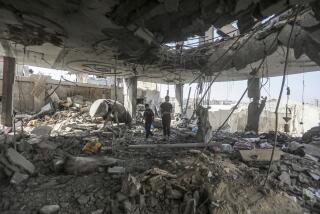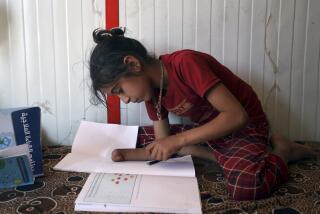Civilian Killings Would Be Minimal, Defense Officials Say
- Share via
WASHINGTON — U.S. defense officials predicted Wednesday that they would minimize civilian casualties if there is a war with Iraq, despite Pentagon plans to unleash an intense bombing campaign, the presence of human shields in Baghdad and the prospect of urban warfare.
Defense Secretary Donald H. Rumsfeld and Army Gen. Tommy Franks, head of the U.S. Central Command, described a war featuring a list of targets that has been honed and vetted over the last 12 years and an air assault with “smart” bombs, designed to paralyze Iraqi forces with a punishing array of pinprick strikes. The campaign would include more, smaller bombs and possibly some novel “nonlethal” weapons.
The result, Pentagon officials said, would be a war that could prove less deadly to civilians than the 1991 Persian Gulf War, in which an estimated 3,500 noncombatants died.
“Our precision capability allows us to keep ... civilian casualties to a lower number than we’ve ever seen in the past. But there will be some,” said a senior U.S. military official who works under Franks at Central Command, which would direct a war in Iraq.
Bush administration officials stressed their efforts to keep down the number of civilian deaths because they are concerned that a large number would intensify opposition to U.S. policy around the world and undermine efforts to rebuild Iraq and foster democratic reforms in the Middle East. As a result, they have insisted that military planners devise rules that keep such casualties as low as possible, even as U.S. forces pursue a more ambitious mission than in 1991, when they drove the Iraqi military out of Kuwait.
Yet even if American and coalition troops avoid killing large numbers of noncombatants in the bombing campaign or in potentially messy urban warfare, intelligence reports suggest that Iraqi President Saddam Hussein would mount an active campaign to convince world opinion otherwise.
In addition to the dangers of urban warfare, civilian casualties could result from Iraq’s alleged weapons of mass destruction and Hussein’s strategy of placing military sites near schools, hospitals and mosques.
The effort to minimize civilian deaths is further complicated by antiwar protesters who have driven to Baghdad to volunteer as human shields and by the possibility that captured U.S. troops and others would be forced to protect sites with their lives, as happened in 1991.
Some Air Force officials have privately complained that vetting procedures to minimize civilian deaths in Afghanistan slowed the time it took to strike critical targets, by some reports causing U.S. forces to miss their chance to kill Taliban leader Mullah Mohammed Omar. Nevertheless, analysts credit the approach with minimizing casualties in Afghanistan.
“Short of urban warfare, the casualties are likely to be surprisingly low,” said Anthony Cordesman, a military analyst and former Pentagon official at the Center for Strategic and International Studies, a Washington think tank. “We’ve adopted new techniques to precisely choose the weapons. We’ve mapped out the cities far better to minimize the risk of civilian casualties.”
Civilian combat casualties in Afghanistan have been unofficially estimated at 1,000 to 1,200, and the organization Human Rights Watch said the use of smart bombs had helped to minimize noncombatant deaths.
But the group has blamed the widespread use of cluster bombs in Afghanistan for the deaths and injuries of scores of civilians, and in a December report it urged that they not be used. Cluster bombs disperse in the air and are designed to kill people or destroy tanks over a several-hundred-yard area. Some turn out be duds that explode long afterward.
“As war looms in Iraq, the United States should learn from the lessons of its Afghanistan air war,” said Bonnie Docherty, researcher at Human Rights Watch. “It should not use cluster bombs at all until the dud rate has been brought way down. At the very least, it should never use cluster bombs near inhabited towns and villages.”
Using satellite and spy plane surveillance, American forces were able to use smaller bombs to destroy buildings in downtown Kabul where Al Qaeda operatives were believed to be meeting while leaving the surrounding buildings on all three sides standing, a senior Central Command official told reporters Wednesday.
In the case of chemical or biological weapons sites, targeters might simply deny the use of such a building by ringing it with temporary land mines dropped from planes, “so you could keep people from going in and taking something out of that facility,” the senior Central Command official said.
Another likely tactic is the use of more, smaller bombs. At least some of the nation’s 21 batwinged B-2 stealth bombers that can carry 16 2,000-pound smart bombs may already have been outfitted to carry up to 80 new 500-pound bombs. Lighter munitions also give Navy fighters, such as the F/A-18, greater range because they can carry more fuel.
“We’re going to smaller and smaller weapons,” said Jake Swinson, a spokesman for the Air Armament Center at Eglin Air Force Base in Florida.
One new weapon that remains shrouded in mystery -- the so-called e-bomb, a high-powered microwave device -- is said to hold the potential to disable power and military facilities without affecting humans. Such a device could conceivably be used on sites ringed by human shields, some analysts have suggested, but Pentagon officials have declined to describe such a device or its capability.
In discussing new weapons Wednesday, Franks indicated that the military had such a capability, but declined to elaborate.
“One example would be offensive electronics. That is a nonlethal sort of weapon. It may be that under certain circumstances, one would see that,” Franks said.
As for military targets such as antiaircraft weapons or tanks near schools, mosques or hospitals, the Pentagon made no promises.
“If a government chooses to co-locate those with one of these protected sites, they lose their status, under international law, as a protected target,” the senior Central Command official said.
Precedent suggests that Hussein will make the most of any casualties that do occur, defense analysts said.
Hussein brought reporters to sites of American bombings in 1991 and cited high civilian death figures, which the Pentagon disputed.
The time-honored tactic of exaggerating the number of noncombatants killed by enemy strikes occurred most recently in the 1997 war in the former Yugoslavia and last year in Afghanistan, military officials said. Pentagon and state officials have privately suggested that Hussein has been storing cadavers to be used to inflate the number of civilians killed in a war with the United States, an act that would violate Islamic customs requiring burial as soon as possible.
More to Read
Sign up for Essential California
The most important California stories and recommendations in your inbox every morning.
You may occasionally receive promotional content from the Los Angeles Times.













